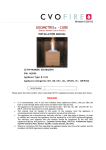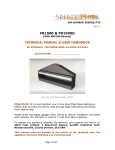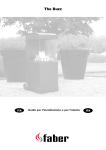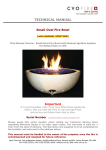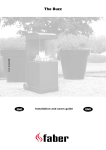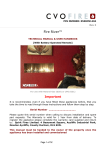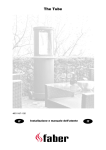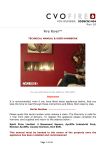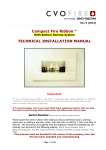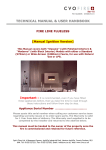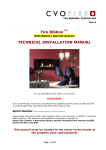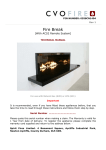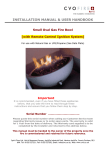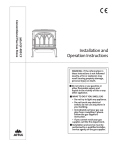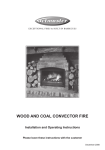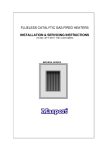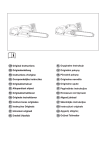Download CAST SLIT Manual
Transcript
PIN NUMBER: 0558BN5708 Rev 5 CAST SLIT TECHNICAL MANUAL & USER HANDBOOK For use with Natural Gas (G20) or LPG (G31) Important It is recommended, even if you have fitted these appliances before, that you take the time to read through these instructions and follow them step by step. Serial Number ……………………………… Please quote this serial number when making a claim. The Warranty is valid for 1 Year from date of delivery. To register the appliance please complete the warranty card supplied and return to the address below: Spirit Fires Limited. 4 Beaumont Square, Aycliffe Industrial Park, Newton Aycliffe, County Durham, DL5 6SW. This manual must be handed to the owner of the property once the appliance has been installed and commissioned Page 1 of 30 Contents Page Page Page Page Page Page Page Page Page Page Page Page Page Page Page Page Page Page Page Page Page Page Page 3 4 5 6 7 8 10 12 13 16 17 19 20 21 23 24 25 26 27 28 28 29 30 Commissioning Certificate Technical Data Introduction Unpacking the Appliance Dimensions Installation Instructions Building & Installation Work Fitting the OPTIONAL Gather Fitting the Metal Enclosure Fitting the Fire Commissioning the Fire Fitting the Fascia Gas Fire User Instructions Lighting the Fire Troubleshooting Spark Failure Pilot Draft Shield Replacement Components Servicing Instructions Cleaning Instructions Warning: Fire Guards & Hearths Warranty Information Contact Details Page 2 of 30 CVO Commissioning Checklist Important Notice Explain the operation of the appliance to the end user, hand the completed instructions to them for safe keeping, as the information will be required when making any guaranteed claims. Reading Flue Check Pass Fail 1. Flue is correct for appliance 2. Flue Flow test 3. Spillage test Gas Check 1. Gas soundness & let by test 2. Standing pressure test [record result] 3. Appliance working pressure (on High Setting) and all other gas appliances switched off [record result] 4. Appliance working pressure (on High Setting) and all other gas appliances switched on [record result] 5. Does ventilation meet appliance requirements Dealer and Installer Information Dealer……………………………………………… Installation Company……………………… ………………………………………………………… ………………………………………………………… ………………………………………………………… ………………………………………………………… Contact No……………………………………… Engineer………………………………………… Date of Purchase…………………………… Contact No……………………………………… Model No………………………………………… Corgi Reg No…………………………………… Gas Type………………………………………… Date of Installation………………………… This product is guaranteed for 1 year from the date of delivery, as set out in the terms and conditions of sale between CVO and your local CVO dealer. This guarantee will be invalid, to the extent permitted by law, if the above Commissioning Checklist is not fully completed by the installer. Page 3 of 30 Technical Data Specifications Pilot Burner Assembly Making Natural Gas: P4-70 SEAGAS LPG/Propane: P4-14 SEAGAS 8mm O.D. tube 127mm 3m 6kg Gas Connection Minimum Flue Diameter Minimum Flue Height Approximate Weight Gas Category Gas Type Category Inlet Pressure Injector Size Heat Input kW gross Setting Pressure (HIGH) Mbar NG I2H 20 460 7.0 17.1 PROP I3P 37 1.45mm 7.0 22.5 Country GB, IE, PT, DK, FI, SE, AT, IT, ES GB, IE, PT, FR, BE, ES Note: There is only 1 Injector per appliance. Enclosure Opening Dimensions Model NOTE Opening Size Height (mm) MAXIMUM 320 Page 4 of 30 Depth (mm) MINIMUM 225 Width (mm) MAXIMUM 505 Introduction This fire is intended for decorative purposes. The installation must be in accordance with National Regulations and must be carried out by a qualified installer. The CAST SLIT is supplied either as: A Complete Suite: This includes a gas fire burner unit, enclosure and fascia. There is an option to fit a gather to the enclosure which has a spigot for a Class 2 (125mm). This should be ordered with the appliance however if this has been missed this can be ordered from Customer Services on 01325-327221. Depending on the stock situation this may take a number of days. Gas Fire Only: The burner only to be installed in a customer designed enclosure. It is the responsibility of the installer to ensure the enclosure and fascia are in line with the CE approval and that ventilation to the burner is provided. Failure to do this will result in the warranty being invalidated. It is recommended by CVO that if the fire is to be fitted into a Class 1 flue that the gather is used in conjunction with the standard enclosure. To comply with the approval this fire must be installed as designed. The fascia must be installed as intended and ventilation to the burner must be provided. Special notice should be taken for the requirements of both the metal and stone fascia versions as the enclosure must be installed differently. If the gas line is longer than 1.5mtrs then the gas line should be increased in diameter to 15mm and possibly larger depending on the length of gas pipe required. Page 5 of 30 Unpacking the Appliance Read these instructions fully before proceeding. Carefully examine the carton for damage before unpacking. If it is obviously damaged, consult the supplier over whether to proceed. Remove the fire and examine its general condition. Any damage or defects must be reported “before” installing the appliance. No claims will be accepted for damage after the appliance has been installed. IMPORTANT: Check the data plate on the appliance to ensure it complies with the gas supply to the property. If satisfied by the condition proceed with the installation. The installation should only be carried out by a GAS SAFE Registered fitter and in accordance with national and local Regulations for gas. The installation must also be in accordance with relevant parts of local and national building regulations. For the Republic of Ireland, reference should be made to IS813 and ICP3 and any guidance notes from Bord Gais. Failure to have the fire fitted by a qualified person nullifies ALL guarantees. Page 6 of 30 DIMENSIONS Note: The fire shown above has a small size stone fascia. The widescreen stone and metal fascia have different dimensions. The enclosure and gather are the same for all styles. Page 7 of 30 Installation Instructions General This fire is intended for decorative purposes. The installation must be in accordance with National Regulations and must be carried out by a qualified installer. Clearances between the fire and all combustible materials must conform to National Regulations. This fire must be installed and used in accordance with these instructions. Prior to installation, ensure that the local distribution conditions (identification of the type of gas and pressure and the adjustment of the appliance) are compatible. The builder's opening or fireplace opening must be constructed of a non-combustible material. For some countries a non-combustible hearth must be fitted in front of the fire in accordance with National Regulations (e.g. United Kingdom). Any flue damper plate or flue restrictor must be removed or fixed permanently in the fully open position, or shall only be fitted in accordance with National Regulations. The chimney must be swept before the appliance is installed. The unit must not be installed unless the chimney/flue length is at least the distance indicated on Technical data (minimum flue height). Before the fire is installed a flue test in accordance with National Regulations should be carried out. Under no circumstances should this unit be installed and operated within any premises with an inadequate flue or chimney system. The gas connection must be in accordance with National Regulations. An isolation valve, or valves, has to be fitted adjacent to the appliance which, when closed, allow(s) the complete burner and control assembly to be disconnected for maintenance or repairs in accordance with national regulations. The pilot light and flame sensing device fitted to this fire is also an atmosphere sensing device. If for any reason any part of the pilot assembly is to be replaced ALL the assembly including the pilot burner, thermocouple, electrode and injector must be exchanged complete for an original manufacturer's pilot Page 8 of 30 assembly. The pilot should not be adjusted or put out of operation by the installer. For some countries a purpose provided air supply must be fitted in accordance with National Regulations. It is recommended that a guard be used for the protection of young children, the elderly or infirm. Due to the newness of the materials, the fire may give off a slight smell for a period of time after commissioning. This is quite normal and any odours should disperse within a few hours of operation. Standard CVO Enclosure and Optional Gather The enclosure is supplied with access holes for gas. Any unused holes should be sealed with metal tape. The enclosure can be installed with or without a trim depending on customer preference. If a trim is provided: 1 – Metal Trim This should be fitted using the screws provided. 2- Stone Trim This may be supplied on a metal plate for fixing to the unit as described in section 1 or bonded directly on to the wall using instant High Grab adhesive. A wooden frame may be needed to be constructed to hold the frame in place while the glue dries. The Enclosure is supplied with an optional Class 2 gather for attachment to a 125mm Flue Liner. This must be requested at time of order. On Most Installations it should be possible to fit the gather into the fireplace opening before sliding in the enclosure box. The gather should then drop down onto the enclosure for securing with the screws provided. If using the appliance in a brick built Class 1 chimney it is strongly advised to use the gather If a gather is required and has not been supplied and is required please call 01325-327221 to order. It is recommended by CVO that if the fire is to be fitted into a Class 1 flue that the CVO gather is used in conjunction with the standard enclosure as this will improve performance and efficiency. Failure to do this may result in burner or enclosure damage due to unstable flame activity. This damage is not covered by the warranty. Page 9 of 30 Building and Installation Work A qualified person should complete all building work; a qualified and competent person to all relevant national legislative controls must carry out the installation of gas burners, mechanical extraction, flue systems and remote control units. Gas Pipe Work If a concealed gas connection is to be made, prepare the pipe work prior to installing the inglenook and fitting the fire. The Gas Supply is via an 8mm inlet to an isolation valve supplied with the fire. A pressure test point is fitted within the isolation valve. If the gas line is longer than 1.5mtrs it is recommended that the pipe work should be increased to 15mm and maybe greater to ensure that the gas pressure is maintained at the specified level at all times. Building work Building work should only commence after a thorough survey of the intended location of the impending installation has been completed and it has been established that the unit can be installed and operated without risk to the owner or tenants of the property or their neighbours. Where existing chimney systems are to be used in conjunction with the CAST SLIT, they should have been swept and undergone thorough examination to ensure that they are in a sound and safe condition, as well as providing an adequate draw when the gas fire unit is in operation. A simple smoke test will reveal whether or not the chimney is working correctly. Installation Procedure It is important that the gas supply is disconnected before any old existing surround and hearth is removed. The CAST SLIT enclosure should be located centrally to the existing flue / chimney at your desired height. If the fire is not placed central to the chimney, the flame picture may pull incorrectly and cause damage to the enclosure and burner. If a flue liner is used the optional gather MUST be used. Page 10 of 30 In some installations it is necessary to install a small lintel unit above the opening, if so an allowance must be made to accommodate the lintel. The CAST SLIT does not have its own support lintel. Opening Sizes The Drawing below should be used as a guide to the required sizes for installation of the Enclosure (with or without the gather) The original fire opening must be closed, using bricks / blocks infill the opening to the required base of the burner, the void behind the brickwork should also be filled; block work or rubble can be used. (It is advisable to install a solid base inside the fire opening to sit the steel framework supporting the burner unit and stone or metal enclosure on to.) It is advisable to allow 15mm clearance in the height of the fire opening; On the base of the fire allow a 15mm bed of cement to bed the burner onto. Page 11 of 30 Fitting the OPTIONAL Gather The gather can be fitted to the enclosure prior to installing into the builders opening or, to keep the opening size down, by inserting the gather into the chimney void and while holding in place slide the enclosure in. If using with the optional Gather, dry fit the gather to the enclosure taking note of where the gather and enclosure overlap. If a flue liner is being used it should be possible to connect the liner and insert the gather into the builders opening then slid the enclosure in. A line of silicon based sealant or metal tape should be used outside the top edge of the enclosure to ensure an airtight seal when fitting the gather. Screw the gather in place from the inside of the enclosure using the 6 screws provided. If a Class 1 Chimney is being used without a liner it is recommended by CVO that the gather is installed to ensure the appliance operates correctly. Page 12 of 30 Fitting the Metal Enclosure Important: When inserting the enclosure into the opening the front edge must be positioned so that it is flush with the “finished” wall. An allowance needs to be made for the plasterboard and finish. The enclosure has 3 inlet holes. The gas supply should be routed in through one of these holes when the enclosure is fitted into the building opening. Important: The inlet is via an 8mm gas pipe. When routing the gas supply note to maintain a good standing pressure we recommend that if the supply line is over 1.5mtrs from the appliance the pipe work should be increased from 8mm to 15mm and possibly 22mm depending on overall length to the meter. A lintel is required as shown in the drawings. The enclosure should be fixed in place using screws and plugs to ensure it cannot move. Page 13 of 30 Shown below the enclosure mounted within the builders opening: Without Optional Gather With Optional Gather Important: When inserting the enclosure into the opening the front edge must be positioned so that it is flush with the “finished” wall. An allowance needs to be made for the plasterboard and finish. Page 14 of 30 If the gather has been used then it should be fixed in place and secured as described in the above section on page 12 Once the enclosure and gather (if used) has been fitted and secured in place and the gas supply routed it is now possible to fit the gas burner unit. Page 15 of 30 Fitting the Fire The inglenook unit is installed within the construction opening. After the inglenook is installed, fitting of the fire can commence. Remove the vanity cover to access the fixing points, isolation valve and gas valve (fig 1). The fire is located and fixed through the two holes drilled within the bottom of the inglenook unit (fig 2). Page 16 of 30 Gas Connection The gas inlet port is positioned on the left hand side of the control valve (viewed from the front as in fig.2 & 3) and is provided with an 8mm compression nut and olive. Use only the nut and olive supplied with the fire. Having decided how to bring in the gas pipe, ensure that it is provided with a gas isolation valve placed within easy reach of the appliance. This is to allow the complete burner and control units to be disconnected for repair and maintenance work, in accordance with national regulations. Ensure that it is suitably purged to remove any loose matter prior to connection. Connect the gas supply pipe and check for gas soundness. Commissioning the Fire WARNING: The high and low flow rates on this appliance are set and sealed at the factory and must never be adjusted. Adjusting the settings will render the fire dangerous. Test The Gas Pressure. Page 17 of 30 Step 1: It is very important that this test is performed as stated to ensure the appliance is safe and reliable. The appliance is supplied with a pressure test elbow and gas tap. Connect an 8mm gas supply to the tap and test for leaks. Remove the screw from the test point within the appliance and connect a manometer. Step 2: Light the appliance as shown in the “lighting the appliance” section. Step 3: Once lit turn the appliance onto the full setting and read the gas pressure from the manometer attached to the inlet test point elbow – WITHIN THE APPLIANCE. The inlet supply pressure must be within (+/- 1mb) of the pressure stated on the Data Plate. For example a 20mBar NG appliance must read between 19mbar and 21mBar. Record the results on the commissioning check sheet. Step 4: Light all other gas appliances in the house, including central heating systems and check the inlet pressure again. Record the results on the commissioning check sheet. Step 5: The pressure must still be within the tolerance of +/- 1mb. Now turn off all the other gas appliances and turn the appliance down to pilot only, the pressure must still be in the tolerance of +/- 1mb. Record the results on the commissioning check sheet. These 3 tests will ensure the fireplace is safe. Step 6: IF FAILED: If it is not possible to maintain the pressure at the required level, TRANSCO, BORD GAIS or the propane supplier must be called to adjust the governor to the house before the appliance can be commissioned further. Step 7: IF PASSED: Disconnect the pressure gauge, replace the pressure test point sealing screw and test the appliance for gas soundness. Insert the front shelf. Step 8: Turn the appliance to the maximum setting. Leave the appliance for 10 minutes and then test that all the products of combustion are entering the flue by traversing the perimeter of the fireplace opening or canopy using a smoke generator e.g. smoke matches. Ste 9: Once the fire and flue have been tested ALL other access holes in the burner tray must be sealed by metal tape. This appliance requires a specific amount of ventilation to function as designed (correct flame picture). This is provided by vents on the fire. These must never be blocked. Step 10: When installing this into an existing chimney with a flue liner the enclosure & gather must be sealed to the existing chimney to ensure that air cannot flow behind the enclosure. Failure to do this could result in serious damage to the burner unit and enclosure. This damage is not covered by the warranty. Any other unused holes must be sealed with metal tape. If using the optional gather - the gather, enclosure and flue liner must be sealed. The products of combustion must only flow out of the enclosure into the chimney. To ensure this the enclosure must be sealed to the construction opening. Step 11: The customer should be shown in detail how to operate the appliance and the installation and user manual given to the customer. The customer must also be made aware that the appliance must be serviced every 12 months and that chimney or flue system should be checked regularly to ensure the appliance operates at optimum performance. Step 12: The warranty card is to be completed by the registered engineer who has commissioned the appliance. This is to validate the warranty. The card must then be given to the customer for return to the factory. Page 18 of 30 Fitting the Fascia The Fascia can now be fitted providing the wall surface is perfectly level both vertically and horizontally. See above image. This shows positive areas that can cause fractures in the facia / surround if fitted to a wall of uneven surface. Failure to fit the fascia to a flat wall will cause serious damage to the fascia which is not covered by the warranty. The enclosure must be flush or forward of the finished wall otherwise the fascia will not fit. Important - If the wall is not level, the wall should be skimmed until level. Metal Fascia This is fitted by inserting into the enclosure opening and fixing with the screws provided. Stone Fascia If this is bonded to a metal backing then the same procedure as the metal fascia should be followed. If supplied as loose pieces these must be bonded directly onto the finished wall using high grab adhesive and a wooden frame. Page 19 of 30 Gas Fire User Instructions General A qualified installer in accordance with National Regulations must install this fire. This fire is intended for decorative purposes. Any purpose-provided ventilation should be checked regularly to ensure that it is free from obstruction. A qualified person should service the fire regularly. After installation, the chimney should be regularly swept and inspected to ensure that all products of combustion are entering the flue and that there is no excessive soot build up on the burner. It is recommended that a guard be used for the protection of young children, the elderly or infirm. A vacuum cleaner may be used, with care, to clean surface of the appliance. Do not throw rubbish et cetera upon the ceramic matting surface. Debris from any source, or soot formed, should be removed from time to time, see ‘Cleaning instructions’. The pilot light and flame sensing device fitted to this fire is also an atmosphere sensing device, which shuts off both the main burner and pilot if evacuation of the combustion products is interrupted. If the fire shuts itself off, do not use the fire, and have the flue and fire checked by a suitably qualified person. Once the flue and fire units have been checked and remedial action taken, the fire is ignited in the manner depicted in section 11.4.2’Lighting the fire’, steps one to six. Due to the newness of materials, the fire may give off a slight smell for a period of time after commissioning. This is quite normal and any odours should disperse within a few hours of operation. The ventilation should be checked regularly to ensure that it is free from obstruction. Page 20 of 30 Lighting the fire The positions of the control valve are depicted on the vanity cover fitted around the control knob (fig 4). If the main burner or pilot light is extinguished for any reason, do not attempt to relight the pilot within 3 minutes. The OFF position is self-explanatory - preventing any gas from passing through the control valve to either the pilot burner or to the main burner. By pressing the control knob in (fig 4), it is possible to turn it anticlockwise. The first function is to turn on the gas to the pilot - this occurs just before reaching the PILOT position. (If the fire has not been lit for some time it may be necessary to hold the knob in this position for some seconds to clear the air from the pipe and allow gas to reach the pilot burner). Once gas is available at the pilot, continued rotation (anticlockwise) will cause the piezo igniter to spark. This is accompanied by a click at the valve and should result in the pilot burner igniting. This can be verified by looking at the front central area of the burner unit. Once the pilot is lit, the control knob should be pressed in and held for 10-12 seconds. In this time the pilot flame will have heated the flame supervision thermocouple sufficiently to operate a hold-on magnet within the valve. The knob should then be turned so that the pointer is approximately horizontal. This allows gas at a high rate to enter the burner and be ignited by the pilot flame. Once ignition has taken place, the fire may be set to any level between MAX and MIN by rotating the control knob accordingly. Fig. 4 To turn off the main burner, turn the control to MIN - press the knob in gently and turn it clockwise to the PILOT position. To turn off the pilot, press knob and turn to OFF. Page 21 of 30 Thus the sequence is: To light: Step 1: From OFF press the control knob in and turn slowly anticlockwise. Step 2: When the ignition click occurs check that the pilot is lit. (If not repeat 1 and 2). Step 3: Hold the knob in for 10 -12 seconds. Step 4: Release knob and check pilot remains alight. Step 5: ignite. Turn knob until pointer is on high rate, the fire should then Step 6: Adjust flames to required level on turning the control knob. To extinguish: Step 1: Turn control knob clockwise to MIN position. Step 2: PILOT. Press knob gently until able to continue turning clockwise to Step 3: To extinguish the pilot press knob and turn to OFF, although the pilot can be left permanently lit, if required. Page 22 of 30 Troubleshooting Symptom Unit sparks but does not light pilot Check List Check for a good spark. Check the spark is in the right area. Check if the ventilation is not too strong and the flame is not blowing off the thermocouple. Check if there is gas running through. Check gas working pressure is correct: NG-20mBar, LPG 37mBar If there is no gas Check isolation tap/shut off valves are free from grease. Check isolation tap/shut off valve are on. Check for blockages Check gas working pressure is correct: NG-20mBar, LPG 37mBar If there is gas but pilot does not light Check gas working pressure is correct: NG-20mBar, LPG 37mBar Check for blockages in pipes Check for draught which can reduce flame Check the pilot gas slot is clear Pilot lights but does not light main burner Check the pilot flame is heating the thermocouple and the is a draft shield fitted if required Check the thermocouple nut is properly tightened into the valve/interrupter block Check that the pilot lights early on ignition clicks Check ventilation is not too strong and the flame is not blowing off the thermocouple Check gas working pressure is correct: NG-20mBar, LPG 37mBar Burner lights but turns off after a few minutes Check thermocouple nut is properly secured to the valve the interrupter block Check ventilation is not too strong and the flame is not blowing off the thermocouple. Check gas working pressure is correct: NG-20mBar, LPG 37mBar Page 23 of 30 Tick Spark Failure The gap between the pilot electrode and the pilot should be 3.5 – 4.5mm and normally adjustment is not necessary (the electrode is very brittle). The spark should jump across the gap between the electrode and the gas outlet on the pilot head. If the ignitor fails, a lighted taper can be inserted into the pilot area to check that gas is reaching the pilot. The pilot must be set up as shown for the fire to function correctly Page 24 of 30 Draft Shield Page 25 of 30 Replacement Components List Part Code Item Description Code Number CVO/V4-28 CVO/P4/70 CVO/P4/14 CVO/460 CVO/J1/45 CVO6/018 CVO6/019 AC026 Engineer Exchange Parts Yes Yes Yes Yes Yes No No Yes User Exchange Parts No No No No No No No No Gas Valve Pilot unit (natural gas) Pilot unit (LPG) Gas injector (natural gas) Gas injector (L.P.G.) Ceramic matting panel Mesh support panel Isolation Tap Anti- draught shield CC041 Yes No Please note that when ordering replacement components or requesting technical assistance, you should at all times quote the following: * * * * Type of fire (model and name) Gas supply (L.P.G. / Natural Gas) Unit serial number Component part number or description of fault Manual Valve Construction Warning: The flow rates are adjusted and sealed at the factory – any adjustment will render the appliance dangerous. Page 26 of 30 Control Knob The control knob is held in place by a grub screw. This can be removed with the allen key supplied with the fire in the fitting kit. Servicing Instructions General The following servicing procedure should be carried out regularly and only by a qualified person. Note: foreign bodies can gather on the surface of the burner unit as it is inevitable that servicing can be a dusty operation. Suitable precautions should be taken. Important: The pilot and flame sensing device fitted to this fire is also an atmosphere sensing device. If for any reason any part of the pilot assembly is to be replaced, the entire assembly including the pilot burner, thermocouple electrode and injector must also be exchanged. The pilot should not be adjusted or put out of operation by the installer. Servicing Procedure Step 1: Turn off the fire and allow it to cool. Step 2: Remove the vanity cover from above the burner unit by removing the fixing screws (see fig 1, page 3). Step 3: Turn off the gas supply at the isolation tap. Page 27 of 30 Step 4: Disconnect the gas pipe from the valve. Lift the fire unit clear of the enclosure unit (see fig 2, page 3). Step 5: Remove the venturi cover screw and venturi cover (natural gas only), then remove and clean the injector. Do not use a needle or wire. It may be necessary to remove the outer fire casing to gain access to the injector. Step 6: Using a soft brush remove any debris from the top surface of the fire unit. Clean the enclosure unit. Step 7: Re-assemble in the reverse order, and re-connect the gas supply. Step 8: Check for gas soundness. Step 9: Check that any purpose-provided ventilation is free from obstruction. Step 10: Re-commission the fire as described in ‘Commissioning the fire’. Cleaning instructions It is inevitable that dust, debris from the chimney and combustion byproducts will accumulate; consequently the surface area of the fire unit should be cleaned at regular intervals. The most effective method of dust/debris removal is achieved with the aid of a very soft brush. However, great care must be taken to ensure that there is no damage to the matting material as this will result in the complete replacement of the matting panel. Step 1: Turn off the fire unit and allow it to cool. Step 2: Once cool, using a very soft brush gently remove any debris/dust from the surface of the fire unit. Warning : Fire Guards & Hearths This appliance is not fitted with an integral guard. In normal use consideration may be given to the use of a fireguard conforming to BS6539 or BS6778, so that the approach to the appliance is limited such that access to the flame is minimised. A fireguard is recommended to the requirements of BS6539 or BS6778 if the fire is used in the presence of young children, the elderly or the infirm. Page 28 of 30 The installer is to advise the user not to stand too close to the appliance for prolonged periods of time and warn that loose clothing is particularly at risk of burning due to the presence of an unguarded flame. In addition, the installer is to advise the user against placing combustible material directly in front of the appliance. Floor coverings, such as carpets, are considered to be acceptable. Hearths For some countries a non-combustible hearth must be fitted in front of the fire in accordance with National Regulations (e.g. United Kingdom). WARRANTY INFORMATION If the appliance develops a fault please refer to the fault diagnosis section earlier in this booklet for possible causes. This appliance is supplied with a 12 month warranty from the date of delivery. The Warranty covers defective parts and does not cover typical wear and tear that occurs with a gas fire appliance. In order to make a warranty claim you will be required to supply the serial number of the appliance [as shown on the front of this book] and full details of the GAS SAFE engineer who installed the appliance - we may request a copy of the installation receipt. To register your appliance please complete and return the warranty card supplied with the fire. Failure to supply details of the Registered Engineer who installed the appliance will invalidate the warranty. To raise a warranty claim call Customer Service on 01325-327221. Page 29 of 30 ONLY USE GENUINE REPLACEMENT PARTS. Spirit Fires Ltd, 4 Beaumont Square Aycliffe Industrial Park, Newton Aycliffe County Durham, DL5 6XN T – 01325 327 221 F – 01325 327 292 The information supplied in this manual is correct at the time of publication; Dated on the 8/11/2010. There may be changes made in future as we improve our products. If there are any queries please write or call our technical department. Page 30 of 30






























